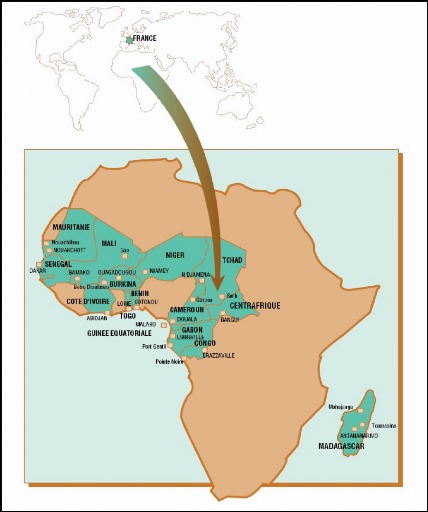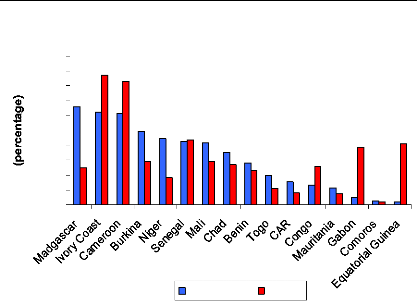Chapter 2: ASECNA's Air Transport Industry
The aim of this chapter is to find out the region's air
transport industry's characteristics. This is an important step as it helps to
understand in which environment ASECNA evolves, and the factors that may
influence its activities. Further details on ASECNA as an organization and its
history are included in appendix 1.
Figure 2.1: ASECNA area in this report

Source: ASECNA
2.1 Economic Characteristics
ASECNA comprises developing countries, mainly located in
western or Central Africa, except Madagascar and the Comoros Islands located in
the Indian Ocean (See map above). Their Economies are relatively weak. Mali,
Niger, Chad, Burkina Faso Togo and the Central African Republic (CAR) are among
the poorest country in the world. The general picture is one of
underdevelopment, political instability, economic volatility and high poverty.
Comparative Gross Domestic Products and populations between ASECNA, the world
average and UK's performance reflect that situation (Table below).
|
Region
|
GDP
($ billion)
|
GDP /Capita
($ thousand)
|
Population
(million)
|
|
ASECNA1
|
93
|
1.7
|
141
|
|
WORLD
|
43920
|
9.5
|
6,526
|
|
UK
|
2218
|
31
|
60
|
Table2.1: Comparative GDP and
populations;
Source: CIA World fact book, 2006
The region accounts for just 0.2 per cent of world
GDP. But in contrast to its low share of economic activity worldwide,
as the table above shows it, 141 million people live in ASECNA, which is 2.2 %
of world population. That combination of low input and high population means
the GDP per capita in ASECNA is the lowest among the world regions (1700
dollars). UK for instance is 24 times wealthier, and its GDP per capita is 26
times ASECNA's average. 46 per cent of the population lives under the poverty
line in the region.
Countries in ASECNA remain to a large extent producers of raw
materials. They export agricultural goods such as coffee, cocoa and cotton, or
mineral such as crude oil and copper. Trade exchanges in ASECNA region tend to
be dominated by agricultural exports.
1 Data compiled from CIA world Fact book 2006
However, economic development is not
homogeneous within the region. Noticeable disparities between
countries exist. For example, while Equatorial Guinea represents only 0.4 per
cent of regional population, it accounts for 8.3 per cent of GDP. In contrast,
Madagascar that contains 13 per cent of total population accounts only for 4.9
per cent of regional GDP. (Figure 2.2)
Figure 2.2: Share of Population and GDP by
country

20
18
16
14
12
10
8
6
4
2
0
% Population %GDP
Source: CIA fact book 2006
Ivory Coast, Cameroon, Senegal, Gabon and Equatorial Guinea
account for almost 60 percent of ASECNA GDP and one third of the population,
while Comoros, Niger, Mauritania, Togo, and CAR own 9.3 per cent of GDP and
host 20 per cent of population.
Regional integration processes are on the
way. ASECNA members countries located in West Africa are part of ECOWAS
(Economic Community of West African States). Those located in Central Africa
are members of CEMAC (Central Africa Economic and Monetary Union). The level of
integration varies significantly. The ECOWAS is much more advanced than the
CEMAC. But the two entities are confronted to the economic
disparities described above, which slow the pace of
integration. The lack of a real political will in CEMAC, or persisting
political instability and civil wars in key countries such as Ivory Coast, and
the Republic of Congo have also had a damaging impact on regional economic and
political integration.
In other respects, bad Governance is a common
practice at the state level and in public companies. States continue to own a
high number of companies in strategic sectors such Telecommunications, Water,
Energy and Transports, although privatisations are spreading across the region,
mainly on the basis of International Monetary Funds Recommendations (IMF). It
is generally admitted that state ownership, «poor management and
monitoring, and anti-competitive arrangements have bred corruption in
Africa» and particularly in the ASECNA area (Morrell, 2005)
These factors, combined with the low level of investments
(Foreign Direct Investments are among the lowest in the world), contribute to
explain the underdevelopment of basic infrastructures, particularly in the
transport sector.
2.2 Transport infrastructure
2.2.1 Roads
Roads are the predominant mode for freight and pas senger
transport in Africa (World Bank, 2005). But within individual countries, very
often, only the main cities are linked by paved roads. Regional interconnection
is very limited. There are only 3 9,000 Kilometres of paved roads in the entire
region, which represents 18 percent of total road network. Moreover, these
roads are often in a relatively bad state due to poor maintenance. In
comparison, UK alone has 392,931 Kilometres of highways, which is ten times
more. That situation renders economic exchanges very difficult and slows their
intensity as well as it limits regional integration.
2.2.2 Railways
Railway links are very poor or do not exist within and between
countries. Two third of the actual rail infrastructure were inherited from the
colonial period (OEDC, 2005, P.22).
There are only 8228 Kilometres of railways in ASECNA countries
(17300 in the UK). Some states such as Niger, Chad, Equatorial Guinea, Comoros,
and CAR have simply no railway infrastructure, which means their economic
activity depends heavily on the road system.
2.2.3 Ports
There are a dozen key ports in ASECNA. The most important of
them is Dakar, with about 10 millions tonnes of goods. The essential of ASECNA
countries trade activities is carried out through these ports. For instance, 98
per cent of exchanges between Cameroon and the outside world are done through
Douala autonomous port, with about 5.2 millions tonnes per year (Mission
Economique, 2006)
But, the reliability and the speed of exchanges of goods and
mobility of people is a crucial factor for regional integration. Given the
under performance of road, and rail systems, and the slowness of sea transport,
the availability of an adequate air transport infrastructure is therefore of
paramount importance for ASECNA countries as they try to integrate into the
world economy.
| 


